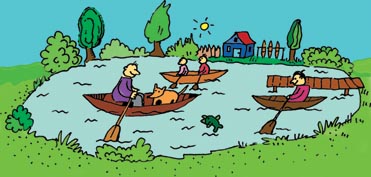BLUE NECKLACE OF ROSSONY
Trail presentation
Blue Necklace of Rossony is a pilot greenway project, which connects two natural reserves: Krasnyj Bor and Sinsha. The trail has been developed for non-motorized users: cyclists, hikers, kayakers, horse-riders and skiers. The backbone trail connects with a network of local walking trails, which provide access to interesting natural and cultural heritage sites.
The backbone trail is a 200 km circular route: Rossony – Klyasticy- Sokolishche – Kulnevo – Yankovichi – Mezhno – Krasnopolje – Ukleenkŕ – Zaborje – Gorbachevo - Rossony.
The Rossony Region has not only outstanding natural and cultural heritage resources, but also numerous community-based ecotourism initiatives designed to make those resources accessible to visitors.

Main tourist attractions and towns along this trail (nature and cultural heritage)
- The Krasnyj Bor Landscape Reserve with its forests and marshes is a natural site of national significance;
- Kulnevo – birthplace of General Y. Kulnev, hero of the War of 1812;
- The Sinsha Reserve with its natural habitats is of great interest to wildlife photographers and naturalists;
- The town of Rossony with its park, war museum and related memorials, Sviato-Voznesenskaja church dating from 1879, Glasko farmstead dating from 1900, and a state forest called the “Rossonsky Leshoz”;
- Fomino – a cranberry reserve;
- Museum of Jankovichi village in Mezhno;
- Sokol Fortress associated with Sokolinsky Castle dating from 1579;
- 1812 War Museum and World War 2 Museum in the Klyasticy village secondary school;
- Open-air museum commemorating partisans in Rovnoe Pole village;
- Borodulkin’s farm – a recreation and health center on Beloe lake;
- Trodovichi village and Francisk Skorina’s farm;
- “Small homeland” of Jan Borshchevskij, the Belarusian and Polish poet, located on Lake Neshchedro.
Annual “Zaborskij Fest” Rural Tourism Festival in Zaborskij Village
The most important rural tourism festival in the area, with a rich cultural programme and local heritage product fair, co-ordinated by – A. Kroll (Agro and Ecotourism Association);
“The Family Good Light” Festival in Albrehtovo Village
The Festival celebrates local history, bringing together the oldest families in the area.
The District Folklore Festival in Jankovichi Village
District Youth Festival in Seljavshchina Village Traditional Festival in Klyasticy Village
Local cuisine, games and dancing.
District “Dozhinki” Festival in Krasnopolje Village
Harvest festival to honour grain farmers, with concerts and a local product fair.
Visit to forest apiary in Yankovichi Village
Visiting the local bee-keeper and taste different kinds of honey.
Visit to an ecology center in Krasnopolje Village
An ecological experimental center.
Horse-riding in Krasnopolje Village
Horse-riding lessons and recreation with A. V. Matsulevich.
“Krynitsa” in Jankovichi Village
Concerts of the “Krynitsa” local folklore group and tasting traditional Belarusian cuisine.
Linking the past to the future
Local folklore songs and dances arranged by contemporary Belarusian composers: Rossony Village - “Svjatica” and “Nadezhda” folklore groupsBiriuzovo Village - Cultural Centre folklore group Local theatre groups: Klyasticy Village
Krasnopolje Village
Zaborje Village
General characteristic of the Greenway
The backbone – a 200 km long ring: Rossony – Klyasticy- Sokolishche – Kulnevo – Yankovichi – Mezhno – Krasnopolje – Ukleenkŕ – Zaborje – Gorbachevo - Rossony – travelling by bicycles, carriages, horses, signposted in green.
Local loops are signposted in blue.
Local loops:
- The Krasnyj Bor Landscape Reserve with its forests and marshes is a natural site of national significance;
- Kulnevo – birthplace of General Y. Kulnev, hero of the War of 1812;
- The Sinsha Reserve with its natural habitats is of great interest to wildlife photographers and naturalists;
- The town of Rossony with its park, war museum and related memorials, Sviato-Voznesenskaja church dating from 1879, Glasko farmstead dating from 1900, and a state forest called the “Rossonsky Leshoz”;
- Fomino – a cranberry reserve;
- Museum of Jankovichi village in Mezhno;
- Sokol Fortress associated with Sokolinsky Castle dating from 1579;
- 1812 War Museum and World War 2 Museum in the Klyasticy village secondary school;
- Open-air museum commemorating partisans in Rovnoe Pole village;
- Borodulkin’s farm – a recreation and health center on Beloe lake;
- Trodovichi village and Francisk Skorina’s farm;
- “Small homeland” of Jan Borshchevskij, the Belarusian and Polish poet, located on Lake Neshchedro.
Length – 200 km
Surface –
mainly floodbank roads with hard surface:forestry/countryside roads – 20 %
floodbank – 60 %
quiet asphalt roads – 20 %
Main users – cyclists, hikers (nature tours), kayakers
Inter-modality possibilities (connections to closest cities/towns and options for using public transport train/bus) – local buses to Polotsk, then Rossony. Accommodation in agro-tourism farms.
Relevant web sites or links: www.ruralbelarus.by, http://www.holiday.by
Available maps and guidebooks
Greenways in Belarus – a catalogue and a brochure containing descriptions of trails and local cultural and natural heritage resources (available in Russian).
Contact to Trail Organization
Alla Khoren - Greenway Coordinator – 'Khoren' farm owner Klyasticy, Rossonsky region, Vitebsk province, Belarus
Tel. +37 2159 24343
Aleksandr Kroll - Greenway Coordinator – 'Krolova Hata' farm owner Zaborje, Rossonsky region, Vitebsk province, Belarus, Tel. +37 2159 25710, e-mail: krolova-hata@tut.by
Agro- and Ecotourism Association: Dunin-Martinkevich str., 6, Minsk, Belarustel. +37 517 2510076, +37 517 2522781, www.ruralbelarus.by








